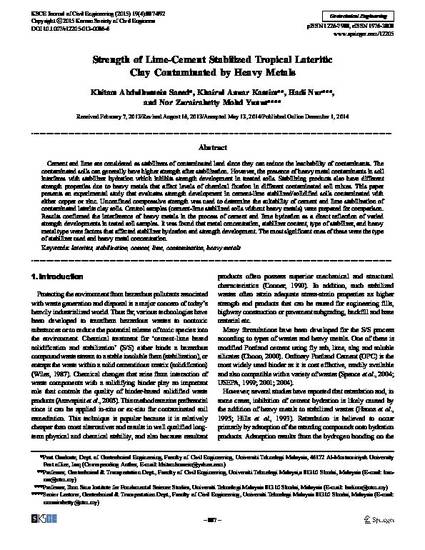
Article
Strength of Lime-Cement Stabilized Tropical Lateritic Clay Contaminated by Heavy Metals
KSCE Journal of Civil Engineering
(2015)
Abstract
Cement and lime are considered as stabilizers of contaminated land since they can reduce the leachability of contaminants. The contaminated soils can generally have higher strength after stabilization. However, the presence of heavy metal contaminants in soil interferes with stabilizer hydration which inhibits strength development in treated soils. Stabilizing products also have different strength properties due to heavy metals that affect levels of chemical fixation in different contaminated soil mixes. This paper presents an experimental study that evaluates strength development in cement-lime stabilized/solidified soils contaminated with either copper or zinc. Unconfined compressive strength was used to determine the suitability of cement and lime stabilization of contaminated laterite clay soils. Control samples (cement-lime stabilized soils without heavy metals) were prepared for comparison. Results confirmed the interference of heavy metals in the process of cement and lime hydration as a direct reflection of varied strength developments in tested soil samples. It was found that metal concentration, stabilizer content, type of stabilizer, and heavy metal type were factors that affected stabilizer hydration and strength development. The most significant ones of these were the type of stabilizer used and heavy metal concentration.
Keywords
- laterites,
- stabilization,
- cement,
- lime,
- contamination,
- heavy metals
Disciplines
Publication Date
2015
Citation Information
Khitam Abdulhussein Saeed, Khairul Anuar Kassim, Hadi Nur and Nor Zurairahetty Mohd Yunus. "Strength of Lime-Cement Stabilized Tropical Lateritic Clay Contaminated by Heavy Metals" KSCE Journal of Civil Engineering Vol. 19 Iss. 4 (2015) p. 887 - 892 Available at: http://works.bepress.com/hadi_nur/103/
